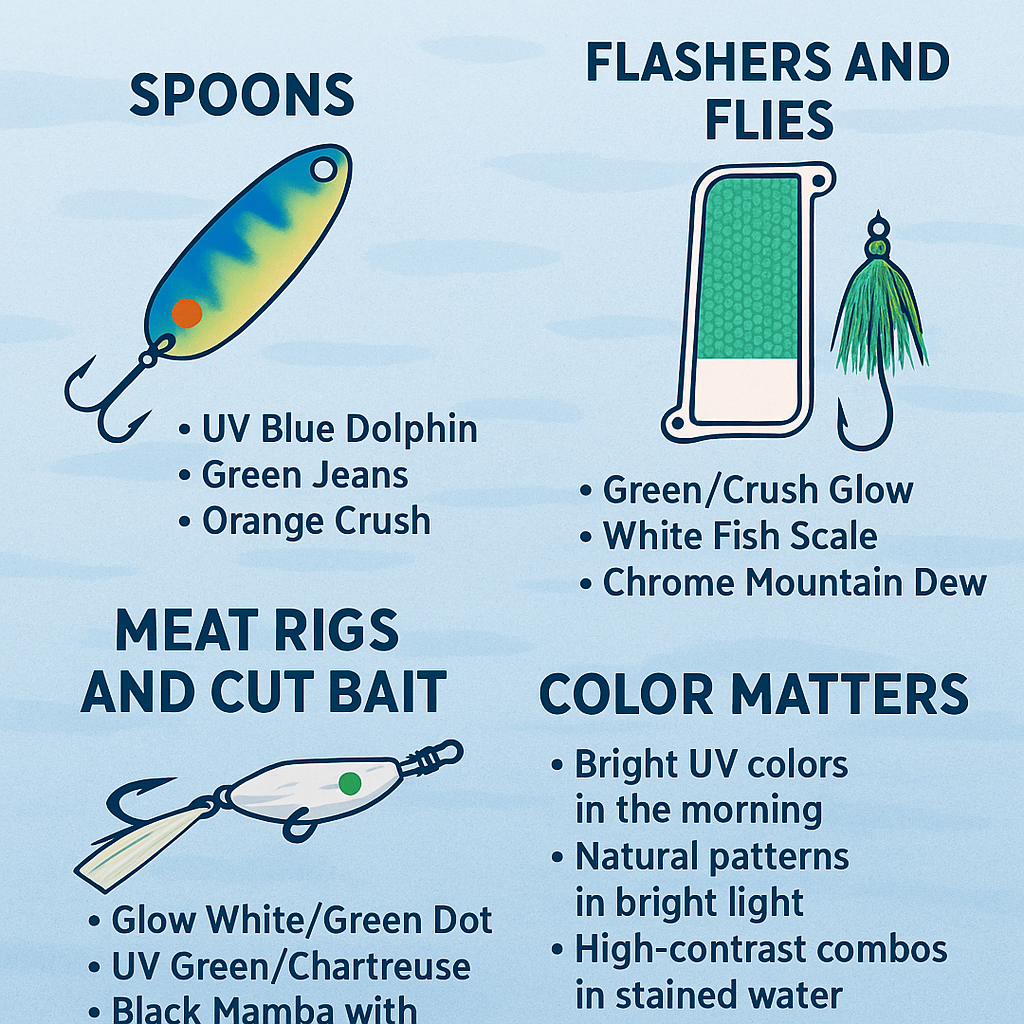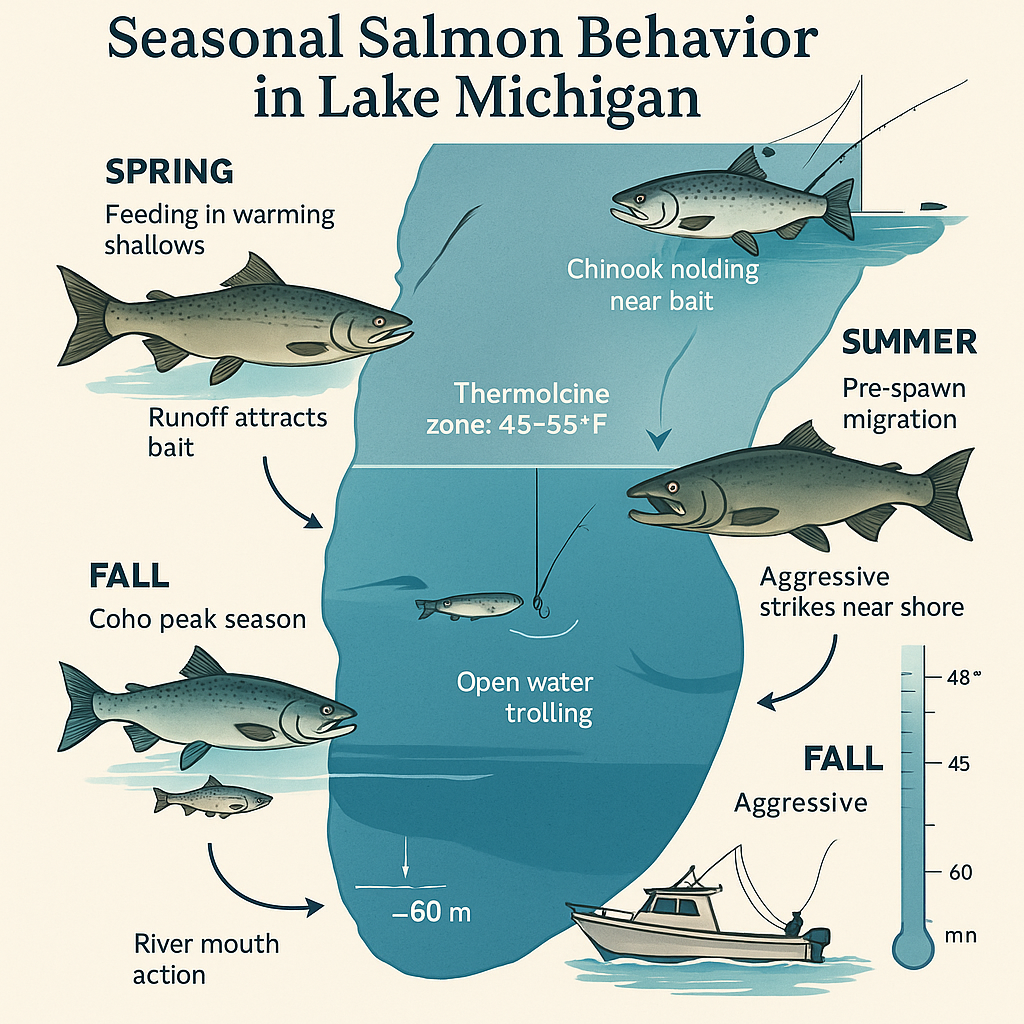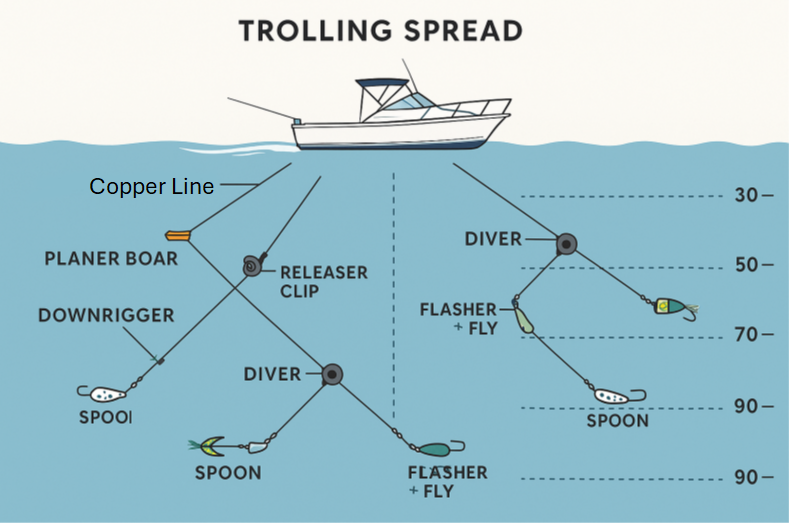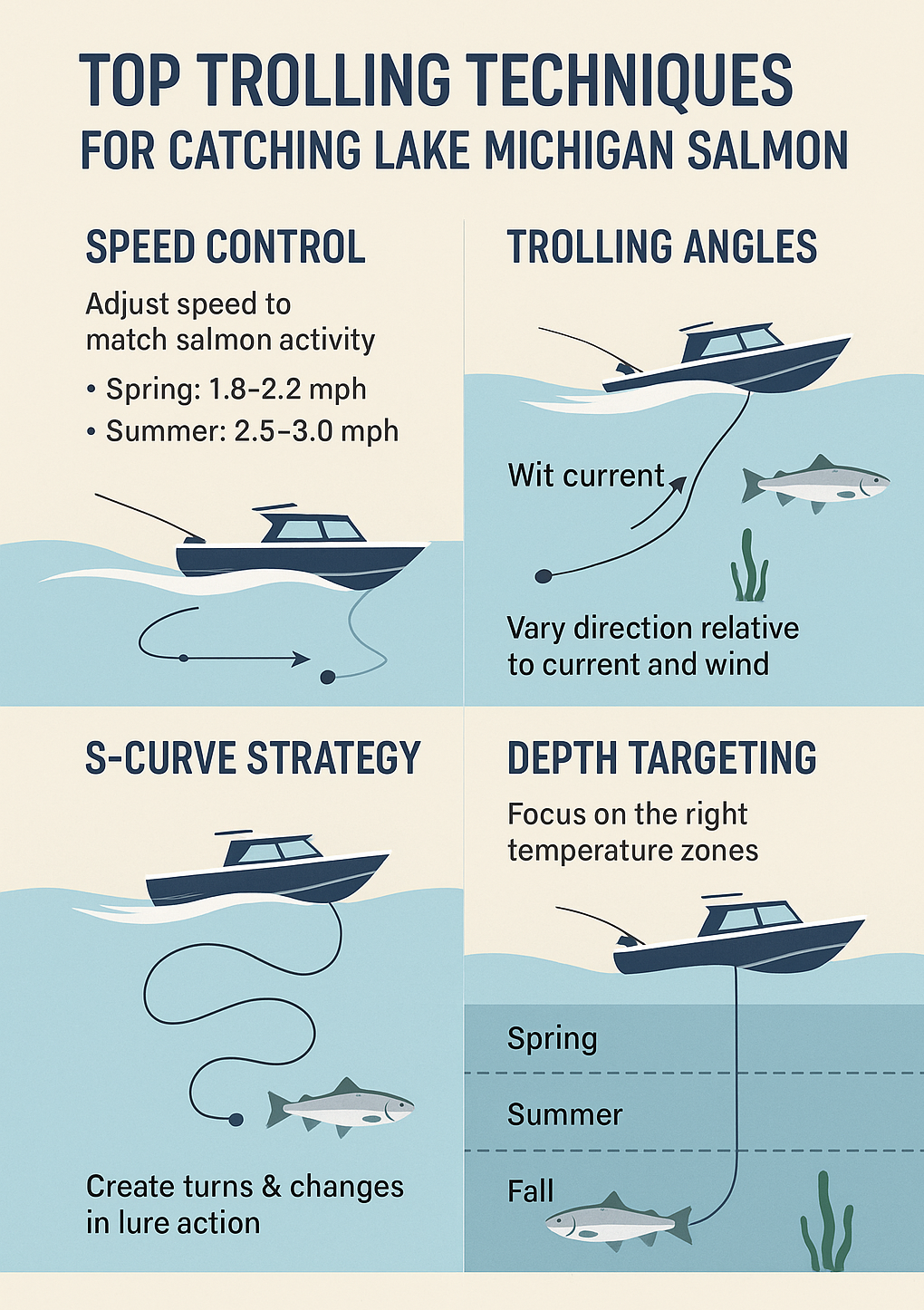 Everything You Need to Know Before Hitting the Water on a Lake Michigan Salmon Charter
Everything You Need to Know Before Hitting the Water on a Lake Michigan Salmon Charter
If you’re heading out on a Lake Michigan salmon charter out of the beautiful port of Saugatuck, Michigan, you’re about to experience one of the most exciting freshwater fishing adventures in the country. But success on the water doesn’t come from luck alone—it comes from experience, preparation, and using the right tackle to trigger bites from powerful, elusive salmon.
One of the most common questions we get on board is: “What kind of lures and bait do you use?” That’s a great question—because on Lake Michigan, trolling for salmon is a game of precision. Every lure has a purpose, every bait presentation has a season, and every color pattern tells a story.
In this post, we’ll break down the go-to lures and bait we use when trolling the waters out of Saugatuck. From spoons to flashers, trolling flies to cut bait, we’ll explain what works, why it works, and when we use each setup throughout the summer and fall seasons. Whether you’re new to salmon fishing or a seasoned angler looking to learn more about our local techniques, this will give you a behind-the-scenes look at the tools and strategies we use every day.
Spoons: Versatile, Effective, and Always in the Spread
Spoons are the foundation of our salmon trolling program, especially early in the season. These curved, flashy lures are designed to mimic injured baitfish, fluttering and wobbling as they move through the water column. Because salmon are predators that often key in on sight and vibration, spoons are an excellent way to cover water and locate active fish.
We typically run spoons on a mix of downriggers, copper lines lines, and copper lines, depending on water depth and temperature. In early summer—June and July—we target Chinook (King) salmon, cohos, and steelhead that are feeding aggressively and suspended in the upper 50–80 feet of the water column. This is spoon season at its finest.
Some of our favorite spoon brands include Dreamweaver, Silver Streak, and Moonshine Lures, known for their durability and consistent action at trolling speeds between 2.2 and 2.8 mph.
Top Producing Spoon Colors:
- UV Blue Dolphin – Great for bright mornings or slightly stained water.
- Green Jeans – Excellent all-purpose choice with high visibility.
- Orange Crush – A go-to for steelhead and cohos, especially in sunny weather.
- NBK (Nasty Boy Killer) – Deadly in overcast or deeper water.
- Glow Bloody Nose – Excellent early morning or low-light option.
As a general rule, we start our spreads with bright UV or glow patterns in the early morning and shift to more natural or metallic finishes as the sun rises. The bite can change quickly, so we’re always rotating spoons in and out to stay ahead of the fish.
Flashers and Flies: The Big Fish Setup
When it comes to targeting mature Kings—especially from late July through September—nothing beats a flasher and fly combo. This two-part rig mimics a baitfish being chased or fleeing, and it’s often the ticket when you want to attract salmon from a distance and get them to commit.
The setup includes a rotating flasher (typically 8 to 11 inches in length), followed by a trolling fly tied on a short leader. The flasher creates a spinning or swinging motion that flashes light in all directions, acting like a dinner bell in deep water. The fly trails behind and finishes the job.
Best Flasher Colors Out of Saugatuck:
- White Fish Scale – Excellent all-around color that works in many water conditions.
- Green/Crush Glow – A proven killer in stained or early-morning conditions.
- Chrome Mountain Dew – Especially effective in sunny, deep-water conditions.
Top Trolling Flies:
- Green Crinkle – A favorite with its subtle flash and action.
- Hypnotist – A consistent producer during staging runs.
- No-See-Um – Simple but deadly, especially when paired with a bright flasher.
We run these rigs deep, usually on wire diver rods, copper lines, or deep downriggers. Leader lengths vary, but most flies are tied on 18 to 24 inches of 50–60 lb fluorocarbon. The action and color combo can make a huge difference, so we pay attention to water clarity, sky conditions, and fish behavior throughout the trip.
On many days, we’ll stack these flashers and flies across the spread, from the middle of the column down to the bottom, to give fish plenty of chances to engage.
Meat Rigs and Cut Bait: When Subtle Presentation Wins
As summer turns to late summer and the Kings start staging for their spawning run, they become less aggressive and more selective. Their metabolism slows, and they often ignore fast-moving lures in favor of something slower, more natural, and easier to eat. That’s where cut bait and meat rigs come in.
Meat rigs use real herring strips inserted into special bait heads that spin slowly through the water. These rigs are usually run behind large flashers to create movement and flash while the bait provides a scent trail and lifelike action. This combination is highly effective when targeting stubborn, big Chinook salmon in August and September.
We use Rhys Davis and John King-style bait heads, often paired with Big Weenie Brand or Pro-Troll flashers.
Favorite Meat Rig Colors:
- Glow White/Green Dot
- UV Green/Chartreuse
- Black Mamba with Chrome Head
When fishing meat rigs, trolling speed is crucial. We slow it down to around 1.8–2.2 mph to maximize the spin and make the bait look like a wounded alewife or shad. Kings key in on scent and profile at this stage, and a well-tuned meat rig can outperform spoons and flies hands-down.
These setups are fished deep—sometimes right near bottom in 90–120 feet of water. Patience pays off here, and when that rod finally doubles over, you know it’s likely a heavy King.
Color Strategy: Light, Water, and Conditions Matter
Color selection isn’t just about picking what looks cool—it’s about understanding how salmon see and respond to their environment.
- Low light (early morning, cloudy days): Glow, UV, and high-contrast colors like black/green or chartreuse.
- Bright light (midday, sunny skies): Chrome, silver, blue/silver, and natural patterns that mimic alewives.
- Stained or rough water: High-contrast and bright UV colors.
- Clear water: Natural finishes and subtle action lures.
We monitor water clarity and light conditions constantly. Onboard, we might change lures every 15–30 minutes early in the day until we dial in a pattern. Once we know what’s working, we double down.
Don’t be surprised to see a deckhand pulling a lure that just caught a fish—because we might be experimenting with something better. The key to consistent success is adaptation.
A Day on the Water: What You’ll Experience
When you book a charter with us out of Saugatuck, you’re stepping onto a boat with hundreds of collective hours of seasonal experience, local knowledge, and gear refined through trial and error.
Here’s what your day typically looks like:
- Early start: We usually leave the dock before sunrise to take advantage of the morning bite.
- Setting lines: We’ll run 8–12 rods using a mix of downriggers, divers, and planer boards. You’ll see spoons on copper lines or copper, flashers and flies on divers, and meat rigs on the deepest rods.
- Constant adjustments: Our crew is always working—changing depths, swapping out lures, tracking temperature breaks with our electronics, and watching for baitfish or fish marks on sonar.
- Hands-on experience: Once we get a hook-up, it’s your turn. You’ll fight the fish and experience firsthand what makes these salmon so fun to chase—long runs, deep dives, and a battle you won’t forget.
- Learning along the way: We’re happy to explain our gear, teach you how to rig a meat head, or show you how to read a temperature probe. Just ask—we love to share.
By the end of your trip, you’ll not only have fresh salmon in the cooler—you’ll have a much better understanding of how Lake Michigan salmon fishing works.
Seasonal Timing: When to Expect the Best Action
Salmon fishing out of Saugatuck is a dynamic experience that changes throughout the summer and into fall. Here’s a rough guide to what to expect:
- June–July: Fast action with spoons and flashers. Kings are on the move, feeding heavily in cooler offshore waters (100–200+ ft). Steelhead and cohos are also common.
- August: Kings begin staging closer to shore (60–120 ft). Flashers and flies dominate. Cut bait starts producing as fish get more selective.
- September: Peak time for staging Kings. The biggest fish of the year are caught now, often on meat rigs or large flies. Fish are nearshore and sometimes in shallow water near river mouths.
- October (if still running): Late-season cohos and steelhead move into the picture. Water cools rapidly and fish begin transitioning toward river runs.
Each period has its strengths, but we tailor every trip to the conditions and target species.
Final Thoughts: Why Gear Matters on a Salmon Charter
Trolling for salmon on Lake Michigan isn’t as simple as dragging a few lures behind a boat. It’s a strategic, ever-changing pursuit that blends local knowledge, seasonal timing, and carefully chosen equipment.
From flashy spoons that draw steelhead strikes on a sunny July morning, to slow-spinning herring strips that tempt a stubborn 25-pound King in the late August fog, every lure and bait in our tackle box has earned its place.
And when you fish with us out of Saugatuck, you’re not just coming along for the ride—you’re part of the team. You’ll see how we think, how we adjust, and how we use lures and bait not just to find fish, but to trigger them to strike.
So bring your questions, bring your excitement, and let’s go fishing. Whether you’re looking to fill a cooler or land a trophy King, we’ve got the tools and techniques to make it happen.
Tight lines—and see you at the dock!

 When you’re heading out on a salmon fishing charter from the scenic port of Saugatuck, Michigan, it’s more than just casting lines and hoping for a bite—it’s about understanding the seasonal rhythms of Lake Michigan’s prized sportfish: Chinook (King) and Coho salmon. These magnificent fish follow distinct migration and feeding patterns throughout the year, and knowing how they behave in relation to water temperature, baitfish movement, and weather shifts can make or break your catch. In this blog post, we’ll take you behind the scenes of what’s happening beneath the surface and show you how we use that knowledge to put fish in the box on every trip.
When you’re heading out on a salmon fishing charter from the scenic port of Saugatuck, Michigan, it’s more than just casting lines and hoping for a bite—it’s about understanding the seasonal rhythms of Lake Michigan’s prized sportfish: Chinook (King) and Coho salmon. These magnificent fish follow distinct migration and feeding patterns throughout the year, and knowing how they behave in relation to water temperature, baitfish movement, and weather shifts can make or break your catch. In this blog post, we’ll take you behind the scenes of what’s happening beneath the surface and show you how we use that knowledge to put fish in the box on every trip. If you’ve booked a salmon fishing charter out of
If you’ve booked a salmon fishing charter out of  If you’re planning a salmon fishing charter on Lake Michigan out of the scenic port of Saugatuck, you’re in for an unforgettable experience. Whether you’re a seasoned angler or casting lines for the first time, one of the key techniques we use to chase down monster Kings and Coho salmon is
If you’re planning a salmon fishing charter on Lake Michigan out of the scenic port of Saugatuck, you’re in for an unforgettable experience. Whether you’re a seasoned angler or casting lines for the first time, one of the key techniques we use to chase down monster Kings and Coho salmon is